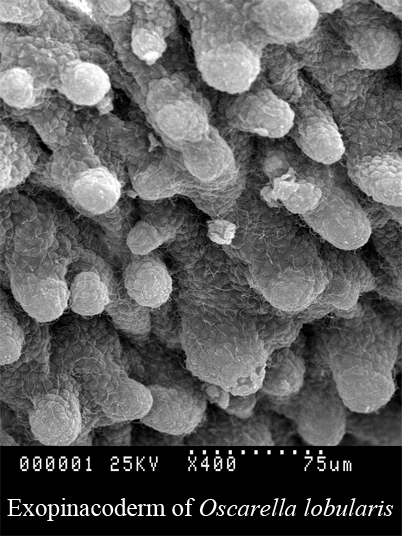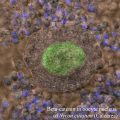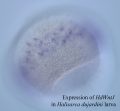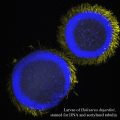Cellular and molecular mechanisms of morphogenesis in sponges (Porifera)
 Sponges (phylum Porifera) occupy a key phylogenetic position in the animal kingdom, but attention to their morphogenesis is given much less than that of drosophila. We study the mechanisms linking the genotype and phenotype – events at the level of cells and molecules that, during morphogenesis (embryonic and postembryonic development, regeneration, metamorphosis) provide a morphological embodiment of genetic information. The main interest for us is the question of how cells in the course of morphogenetic processes “understand” what to do? What signaling mechanisms provide these processes? How are the axes (antero-posterior, apical-basal) developed in development, or during regeneration after mechanical damage, or by the development of a conglomerate of somatic cells? Understanding the molecular genetic level of these processes occurring in the ontogenesis of Porifera gives a completely new approach to the interpretation of data on the evolution of the lower Metazoa.
Sponges (phylum Porifera) occupy a key phylogenetic position in the animal kingdom, but attention to their morphogenesis is given much less than that of drosophila. We study the mechanisms linking the genotype and phenotype – events at the level of cells and molecules that, during morphogenesis (embryonic and postembryonic development, regeneration, metamorphosis) provide a morphological embodiment of genetic information. The main interest for us is the question of how cells in the course of morphogenetic processes “understand” what to do? What signaling mechanisms provide these processes? How are the axes (antero-posterior, apical-basal) developed in development, or during regeneration after mechanical damage, or by the development of a conglomerate of somatic cells? Understanding the molecular genetic level of these processes occurring in the ontogenesis of Porifera gives a completely new approach to the interpretation of data on the evolution of the lower Metazoa.
We have a transcriptome of the our model species, Halisarca dujardini; in cooperation with foreign colleagues, sequencing and assembly the genome, sequencing of transcriptomes of different types of cells takes place. Work is underway to study Wnt and TGFbeta signaling pathways in the development, regeneration and formation of the primomorphs.
Participants
Alexander V. Ereskovsky, PhD, DSc, professor, Department of embryology SPbU
Ilya Borisenko, MSc, assistant professor, Department of embryology SPbU
Publications
1. Ereskovsky AV, Richter DJ, Lavrov DV, Schippers KJ, Nichols SA. Transcriptome sequencing and delimitation of sympatric Oscarella species (O. carmela and O. pearsei sp. nov) from California, USA. PLoS One. 2017 Sep 11;12(9):e0183002. doi: 10.1371/journal.pone.0183002
2. Fierro-Constaín L, Schenkelaars Q, Gazave E, Haguenauer A, Rocher C, Ereskovsky A, Borchiellini C, Renard E. The Conservation of the Germline Multipotency Program, from Sponges to Vertebrates: A Stepping Stone to Understanding the Somatic and Germline Origins. Genome Biol Evol. 2017 Mar 1;9(3):474-488. doi: 10.1093/gbe/evw289.
3. Ilya Borisenko, Marcin Adamski, Alexander Ereskovsky and Maja Adamska. Surprisingly rich repertoire of Wnt genes in the demosponge Halisarca dujardini // BMC Evolutionary Biology. 2016. Vol.16, p. 123.
4. Alexander V. Ereskovsky, Ilya E. Borisenko, Pascal Lapébie, Eve Gazave, Daria B. Tokina, Carole Borchiellini. Oscarella lobularis (Homoscleromorpha, Porifera) Regeneration: Epithelial Morphogenesis and Metaplasia // PLoS ONE. 2015. 10(8): e0134566
5. Borisenko IE, Adamska M, Tokina DB, Ereskovsky AV. Transdifferentiation is a driving force of regeneration in Halisarca dujardini (Demospongiae, Porifera) // PeerJ. 2015. 3:e1211
Foundation
SPbU grants: 1.41.1114.2017, 1.41.1437.2014, 1.38.209.2013, 1.42.414.2013, 1.41.2273.2013, 1.42.1693.2011.
Russian Foundation for Basic Research: 16-04-00084-а, 13-04-01084-а, 10-04-91053-НЦНИ_а.
Russian Science Foundation: 17-14-01089.
Collaboration with external organizations
Institut Méditerranéen de Biodiversité et d’Ecologie marine et continentale (France): Dr. Emmanuelle RENARD, PhD; Dr. Carole BORCHIELLINI, PhD
Moscow State University: Andrey Lavrov, PhD
Australian National University, Research School of Biology (Australia): Dr. Maja Adamska, PhD
RIKEN-KFU Translational Genomics Unit (Japan): Dr. Oleg Gusev, PhD



